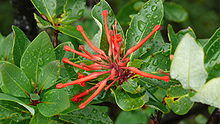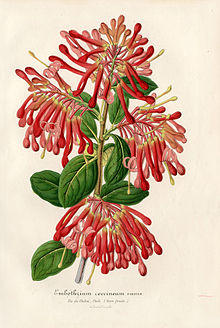| Embothrium coccineum | |
|---|---|
 | |
| Flowers of Chilean firetree | |
| Scientific classification | |
| Kingdom: | Plantae |
| Clade: | Tracheophytes |
| Clade: | Angiosperms |
| Clade: | Eudicots |
| Order: | Proteales |
| Family: | Proteaceae |
| Genus: | Embothrium |
| Species: | E. coccineum |
| Binomial name | |
| Embothrium coccineum J.R.Forst. & G.Forst. | |
Embothrium coccineum, commonly known as the Chilean firetree, Chilean firebush, notro, or ciruelillo in Spanish, is a small evergreen tree in the flowering plant family Proteaceae. It grows in the temperate forests of Chile and Argentina.
Description
The Chilean firetree grows 4–15 m (13–50 ft) tall and can reach 50 cm (20 in) in diameter. The bark is dark grey with light spots and the wood is light pink in color. It produces clusters of deep red flowers (occasionally pale yellow) and flowering occurs in spring. The fruit is a dry follicle, with about 10 seeds inside.
Uses
It is grown as an ornamental in Great Britain and the United States, and as far north as the Faroe Islands at 62° North latitude.
The plant was introduced to Europe by William Lobb during his plant collecting expedition to the Valdivian temperate rain forests in 1845–1848. It was described by Kew Gardens as:
"Perhaps no tree cultivated in the open air in the British Isles gives so striking and brilliant a display as this does."[1]
The wood being very soft but durable, is used for making spoons, kitchen vessels and other craft articles.
Ecology
It is pollinated by both hummingbirds and insects in its natural range.[2]
Cluster roots
Like other members of the family Proteaceae, E. coccineum seedlings produce dense root masses called cluster roots or proteoid roots that provide access to normally inaccessible forms of various nutrients, especially phosphorus. Cluster roots exude acidic substances which are able to convert the otherwise inaccessible forms of nutrients into forms that are biologically useful. These nutrients are then made available to other plants from the leaf litter of E. coccineum, making it a valuable keystone plant in certain terrains.[3]
References
- ^ Quoted in Sue Shephard (2003). Seeds of Fortune - A Gardening Dynasty. Bloomsbury. p. 100. ISBN 0-7475-6066-8.
- ^ Devoto, M., N. H. Montaldo & D. Medan, 2006. Mixed hummingbird: Long-proboscid-fly pollination in ‘ornithophilous’ Embothrium coccineum (Proteaceae) along a rainfall gradient in Patagonia, Argentina. Austral Ecology, 31: 512–519
- ^ Piper, Frida I., Gabriela Baez, Alejandra Zúñiga-Feest, and Alex Fajardo. 2013. Soil nitrogen, and not phosphorus, promotes cluster-root formation in a South American Proteaceae, Embothrium coccineum. American Journal of Botany 100:2328-2338. doi:10.3732/ajb.1300163 Reported at Eurekalert, January 23, 2014
External links
- "Embothrium coccineum". Encyclopedia of Chilean Flora. Retrieved 2009-06-27.
- "Embothrium coccineum". Chilebosque. Retrieved 2009-06-27.
- Chilean Fire-tree description by Arthur Lee Jacobson
